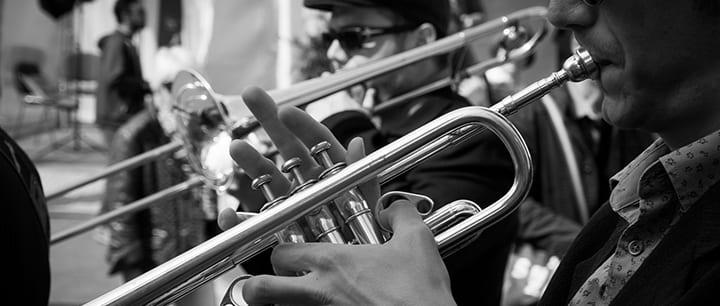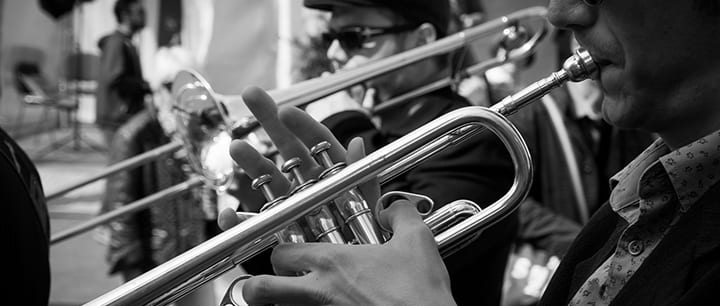Whether you play saxophone, piano, bass, or another instrument, jazz can be a really fun genre to explore! To get started, check out these jazz improvisation tips from Brookings, SD teacher Carl S…
One of my favorite things about making music is jazz improvisation. Jazz style is a lot of fun, but adding improvisation to that is essential. I, like many of my students, was afraid to improvise at first. Here are some helpful jazz improvisation tips for starting out.
Before Step One
Before anything else, be honest with yourself and identify what level you’re at. If you’re a true beginner, the worst thing that you can do is try to instantly memorize what all of the chord symbols mean. Yes, they are important, but this is not step one. Even if you’re just starting out with your instrument, you can begin by training your ear.
Step One
The first thing I have a student do is jam out on one note. I set up a play-along track, or even just a metronome, and then I play a measure of some rhythmic idea. Then, I have the student copy me. We repeat this several times, paying extra attention to style and articulation. Then, I expand to playing three note, then five, etc. All students can do this, and it is easy to customize to their needs.
Remember to Have Fun!
How do you get better between lessons? When I was in middle school, one of my favorite things to do was play along with the radio. I’d play mainstream radio melodies on the saxophone, not even realizing how important this was to my future as a musician. I was training my ear and having fun doing it!
Start with Simple Music Theory
Once you can do this, it’s probably time to start checking out some chord symbols. A lot of people start with the blues progression, but that’s a lot of fast changing chords for a beginner. I prefer to start with a slower paced AABA form, such as a tune like “Impressions” or “So What”. Learning two scales and having plenty of time to clearly hear the harmony changing makes this transition much easier.
The Blues
Now’s the time to try the blues. Many band directors will teach you the “blues scale” at this point. While this is a quick fix for band directors to get students to play something for a concert, it is not really considered playing the changes of a blues form. I suggest looking at Jamie Aebersold’s Play-Along Volume 54 “Maiden Voyage”. These books and many other great resources are available at www.jazzbooks.com. This series of play-along books is very well known to jazzers, and there are well over 100 volumes made for all instruments. Check out the third tune called “Bb Blues”.
More Difficult Chord Progressions
From here, chord progressions get more difficult. The Aebersold books can be very helpful, since they spell out the scale for each chord symbol. At this point, it is very easy to develop a habit of only improvising while staring at the page. Don’t forget to use your ear!
Learning Tunes
The Real Book Volume I (6th Edition) is available at www.jazzbooks.com as well as many other places, including iBooks. This is a book with hundreds of standard jazz tunes, and there are several volumes and categories. The tempting thing to do is to learn these tunes by reading, however, it is better to learn them by ear. To do this, start by picking an easy tune that’s in the book, find it on YouTube being performed by the original artist/composer, and go from there.
Additional Resources
Aebersold has created play-alongs for these books, but there is a cheaper and more customizable option. I use an app called iReal Pro, which is inexpensive and always with me on my phone. First, download the app, then add the content, which includes over 1,000 songs. From here, you can transpose, add dozens of repeats for practice, change tempos, etc.
This is a lot of information, but if you first identify what level you’re at and keep these jazz improvisation tips in mind, you’ll be gigging like a pro in no time!
 Carl S. teaches saxophone, music theory, piano, and more in Brookings, SD. He completed his Doctor of Musical Arts degree in saxophone performance at the University of Kansas in 2014, and his Master of Music Pedagogy and Performance from Oklahoma State University in 2011. Learn more about Carl here!
Carl S. teaches saxophone, music theory, piano, and more in Brookings, SD. He completed his Doctor of Musical Arts degree in saxophone performance at the University of Kansas in 2014, and his Master of Music Pedagogy and Performance from Oklahoma State University in 2011. Learn more about Carl here!
 Photo by sebastien letellier
Photo by sebastien letellier
Suzy S.

